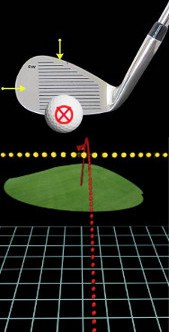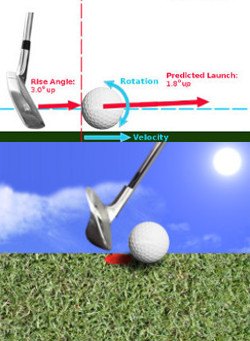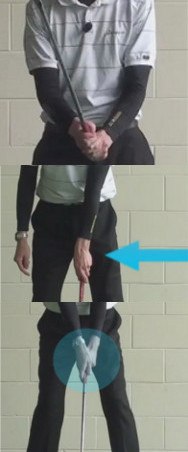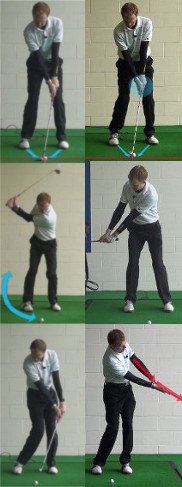There are few feelings in golf that are quite as nice as striking a clean, crisp wedge shot which flies up to the target, lands near the hole, and stops quickly.

Hitting a shot like this is sure to impress your friends, and it is going to pay dividends on the scorecard, as well. Of course, you already know that it isn’t necessarily easy to hit such quality wedge shots. While wedge shots are usually some of the easier shots you’ll run into during the course of a round, they still present their own unique challenges. If you are committed to playing this game at a higher level, one of the best things you can do is learn how to consistently strike crisp wedge shots.
One element that is often overlooked when the discussion turns to clean ball striking is the grip. If you are going to hit clean shots, you’ll want to make sure you have the right kind of grip in place to do so. Will a good grip alone help you clip the ball cleanly off the turf over and over again? No, probably not. It is a big step in the right direction, however, and you will have one less thing to worry about when you practice. Take time now to get your grip right and check that item off of your golf to-do list.
Fortunately, the grip that you use to hit crisp wedge shots will barely be different – if it is different at all – from the grip that you use to hit the rest of your shots. If you are able to use the same grip for all full swing shots, that would be ideal. If you can’t quite make that work, however, the next best thing is to make the smallest possible adjustments in order to achieve the desired results. Making big changes from shot to shot in golf is always going to be challenging and do so will almost certainly limit your ability to produce consistent results. Feel free to customize your technique in ways that help you perform better, but always keep the goal of continuity in the back of your mind.
All of the content below is based on a right-handed golfer. If you happen to play left-handed, please take a moment to reverse the directions as necessary.
What It Means to Hit a Crisp Wedge

Even if you are a relatively new golfer, you’ve probably heard the term ‘crisp’ wedge shot before. But what does it mean? Before we can really get into the nuts and bolts of this article, we need to make sure you clearly understand what it means to hit the ball crisply.
Basically, when golfers talk about crisp wedge shots, they are talking about shots that are hit perfectly clean, without any degree of thin or fat contact. The club is moving down through the ball nicely at impact, so that the ball is pinched against the turf and set off into the distance. Crisp shots tend to have good spin rates, so they stop relatively quickly after they land. Also, since you have hit the ball so cleanly, the shot is typically going to fly about as far as you expected. In addition to avoiding thin or fat contact, you are also going to strike crisp wedge shots right on the sweet spot of the club face. That is another piece of the puzzle that is going to help you achieve great results.
When a wedge shot is struck perfectly, it makes an unmistakable sound that experienced golfers will recognize right away. There is a clear ‘click’ created when the club head strikes the ball. If you hear that sound, you almost don’t even need to watch the shot fly – you can just be sure it’s going to be a good one. It should be stated that we are talking specifically about hitting wedge shots from the fairway when discussing crisp contact. It’s basically impossible to make this kind of contact from the rough, unless the rough on the course you are playing is particularly thin and wispy. Think of this is even more motivation to keep your ball in the fairway whenever possible. While in the short grass, you’ll have the opportunity to hit a crisp wedge, and doing so just may set you up with a makeable birdie putt. It’s the simple things that add up to good rounds of golf, and one of the key simple concepts in this game is keeping the ball in the fairway.
One of the many benefits of striking crisp wedge shots is the positive impact that this kind of ball striking can have on the rest of your game. When you hit your wedges crisply, there is a pretty good chance you’ll hit many of the rest of your clubs nicely, as well. That is especially true of the middle irons, which play an important role in the game of golf. Depending on which set of tees you choose to play, and depending on how far you hit your driver, it is possible that many of your approach shots during a given round will be played with mid-irons. If you are able to translate your crisp wedge play into solid mid-iron swings, those approach shots may be able to find the green at a high rate.
To summarize, a crisp wedge shot is one that you strike perfectly clean from a nice lie in the fairway. The ball will make a beautiful ‘click’ sound as it comes off the face of your wedge, and there will be plenty of spin on the ball to stop it shortly after it lands. If you feel like the current state of your wedge game is holding you back from reaching a new level of performance on the course, working on the quality of your ball striking would be a great next step.
The Role of the Grip

On some level, the role of the grip in the golf swing is pretty obvious. After all, the grip is the only way that your body is connected to the club during the swing, so you aren’t going to be able to hit any shots at all without some kind of grip. But what is it about hitting wedge shots that makes the grip particularly important? And what elements should be included in your grip to successfully produce crisp contact? Let’s take a look.
First, let’s talk about why the grip matters so much in the wedge game. Actually, let’s back up and talk about longer iron shots before we talk about the wedges. When you are playing an approach shot with something like a six- or seven-iron, chances are good that you are making a full swing. You are just trying to hit the ball the standard distance that it will usually travel when you use that club, because you’ve decided that it is the right club for the job. Sure, maybe it is likely to come up a few yards short of the hole, but that’s okay – hitting the ball to just a few yards away from the hole is a good result from back in the fairway. As you get closer to the green, however, the story changes a bit. With a wedge in your hands, you really aren’t going to be happy with just hitting the green and setting yourself up with a 30-foot putt. Instead, you want to hit it close, so you have a chance to make the putt – hopefully for birdie. In order to hit wedge shots close to the hole, you can’t just make the same full swing each time. Instead, you have to tailor your swing based on the yardage and other factors that you face.
Let’s turn our attention back to the grip. Knowing that you need to produce a variety of different distances with each of your wedges, you’ll need a comfortable and reliable grip to help you swing through the ball cleanly. If your grip is awkward in some way, it may make it difficult to change your swing to modify your distance. For example, picture a wedge shot where you need to take about 10 yards off of the normal distance of the club in order to get close to the hole. With a proper grip in place, you would simply shorten up your backswing a bit and move the ball back in your stance in order to do the job. However, if your grip is faulty, this might not work. The way you release the club on your full swings might not translate to this modified swing, and the results will be ugly in the end. Basically, you need a grip that is versatile enough to let you make a variety of different swings while still achieving great results.
What does such a grip look like? The following keys and techniques are a good place to start.
- Light grip pressure. If you only take one thing away from this entire article, let it be this point. If you are going to consistently strike crisp wedge shots, you need to use a light grip pressure both before and during the swing. It’s just that simple. Many golfers make the mistake of squeezing the club too tightly at address, and that tension tends to carry on into the swing. With a tight grip, the hands won’t allow the club to release properly through the hitting area, and you’ll struggle to strike the ball cleanly as a result. Of course, you don’t want to hold the club so lightly that the club goes flying out of your hands during the swing, so you have to strike a balance here. Strive for a grip pressure level that lets you keep control over the club during the swing while still permitting you to move the club head freely through the impact zone.
- Hands facing each other. This is a tip that you may not have heard before, but it is one which can really help to solidify your grip. When you build your grip, you are almost certainly going to start by placing your left hand on the club. With your left hand in place, you’ll then add your right hand in order to complete the grip. As you place your right hand on the club, make sure the palm of your right hand is facing the palm of your left hand as directly as possible. Matching your palms up in this way is going to help you create a secure, stable grip that feels solid from the start of the swing through to the finish.
- Nothing too extreme. There is plenty of room for personal preference and style in the grip. You need the club to feel comfortable in your hands, and that means you need to go with what feels good to you. Ideally, you will be able to find a grip that feel natural while still remaining within the generally accepted grip fundamentals, such as the two points listed above. With that said, you would be wise to avoid anything too extreme in your grip, such as a dramatically strong or weak position with your left hand. If you venture into the territory of the extreme with your grip, it’s quite likely that you will limit your versatility on the course. You might be able to hit one type of shot nicely with your extreme grip, but changing your trajectory to meet the demands of the shot at hand may be impossible. Try to keep your grip in the relatively normal territory so you can adapt properly as necessary.
It’s going to be hard to hit crisp wedge shots without a trusty, reliable grip. When you do take some time to get down to work on the way you position your hands on the club, remember that any changes you make to your grip are likely to take time to become comfortable. Don’t get frustrated after just one or two practice sessions – see it through and be patient until your feel for the new grip improves.
One Possible Adjustment

In the introduction to this article, we mentioned that the grip you use to play your wedge shots will only vary slightly from the grip you use for your other clubs, if it varies at all. It would be great if you can use the same grip for every shot you hit, but that just might not work out in the end. If you do feel like you need to adjust your grip slightly when hitting wedges to improve the quality of contact, the adjustment suggested in this section is where you should start.
Quite simply, the adjustment we are presenting here is turning your left hand slightly to the left at address, and then turning your right hand to match. As you likely know, turning your hands to the left is going to result in the use of a ‘weaker’ grip, and that can be a good thing in this case. We want your hands to stay stable through the hitting area, with your left wrist mostly flat when you strike the ball. This is the position that is going to enable you to hit crisp wedge shots. You shouldn’t be turning your hands dramatically to the left, but just a slight adjustment may do wonders for the way the ball comes off of your wedges.
Of course, if you already use a weak grip, this adjustment is not going to be necessary. Your left wrist will already be in a good position (most likely) at impact, so don’t try to turn your grip any farther. This is a tip which is aimed at golfers who use a strong grip for their full swing, which is a significant percentage of the population. A strong grip has a lot to offer when hitting full shots like drivers and long irons, but the usefulness of the grip starts to decline when you get into wedge territory. By opting for a weaker grip with the wedges, you may be able to produce the kind of solid contact we have been talking about in this article.
It probably sounds simple enough to just turn your hands a bit to the left at address, but unfortunately, that’s not the end of the story. To make this adjustment work, you also need to make sure you are turning your body through the shot properly all the way into the finish. Without a good turn toward the target in the downswing, the face of the club will likely hang open and you’ll almost certainly miss right. If you are able to blend the slightly weaker grip with a great turn through the downswing, you will be on a path toward improved results.
Crisp Chip and Pitch Shots

For our last section in this article, we are going to move even closer to the green for a discussion on chip and pitch shots. These shots are generally played with wedges, of course, and it’s just as important to make crisp contact here as it is when making full swings. However, since we are talking about small swings here rather than full swings, the keys to crisp contact are somewhat different. Review the tips below before your next short game practice session.
- Steady head position. Any time you are talking about the short game, the conversation needs to start with a steady head position. Everything is going to stem from this one fundamental – get it right on this point, and the rest of your task becomes much easier. Fail to keep your head steady, however, and it will be nearly impossible to live up to your potential in the short game. Set up over the ball with your head in a comfortable position and do your best to keep it there throughout the swing. Specifically, you don’t want to allow your head to come up as you are making contact with the ball. Keep your head in place as the club swings through, and only look up once you are sure the ball is already on its way.
- Hands in front of the ball at impact. This is an extremely valuable tip that you would be wise to keep in mind as you practice. When you make contact with the average chip or pitch shot, you want to make sure that your hands are in front of the position of the ball slightly. This is going to promote a downward hit through the ball, helping you to achieve the kind of clean contact you desire. The only time you may deviate from this plan is when trying to hit the ball particularly high, such as when you are playing a flop shot. In that case, you may want to leave your hands just behind the ball at impact, so you can maximize the amount of loft you expose to the ball.
- No rush. Even if you have good technique in place throughout your chip and pitch swings, all of those solid mechanics can be wasted if you rush through the shot. You need to take your time when swinging the club on a chip or pitch shot, just as you do when playing any other kind of shot in this challenging game. Rushing is particularly common in the short game because players tend to get nervous about the results of the shot at hand. Do your best to set those nerves to the side and stick with the tempo you established in practice.
The grip is only one piece of the puzzle when it comes to producing quality, crisp wedge shots, but it is an important piece to be sure. We hope you have taken away some valuable pieces of advice from this article, and we hope you begin to make improved contact with the ball in the near future. Good luck!





